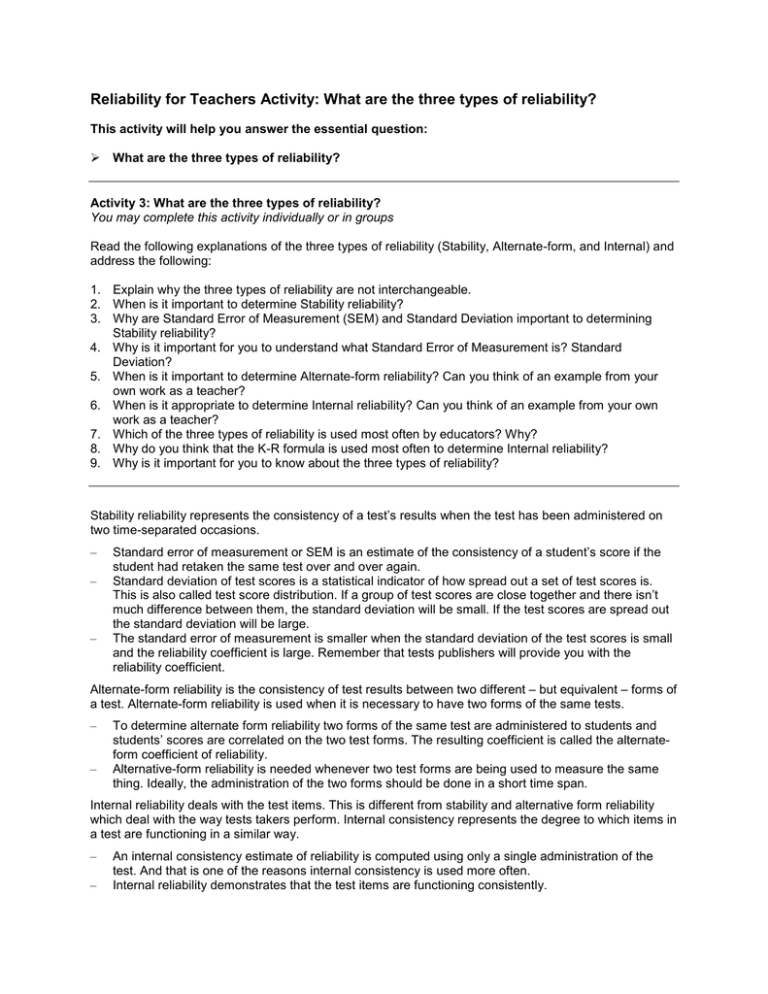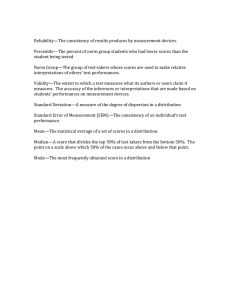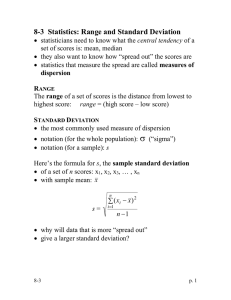Reliability for Teachers Activity: What are the three types of reliability?
advertisement

Reliability for Teachers Activity: What are the three types of reliability? This activity will help you answer the essential question: What are the three types of reliability? Activity 3: What are the three types of reliability? You may complete this activity individually or in groups Read the following explanations of the three types of reliability (Stability, Alternate-form, and Internal) and address the following: 1. Explain why the three types of reliability are not interchangeable. 2. When is it important to determine Stability reliability? 3. Why are Standard Error of Measurement (SEM) and Standard Deviation important to determining Stability reliability? 4. Why is it important for you to understand what Standard Error of Measurement is? Standard Deviation? 5. When is it important to determine Alternate-form reliability? Can you think of an example from your own work as a teacher? 6. When is it appropriate to determine Internal reliability? Can you think of an example from your own work as a teacher? 7. Which of the three types of reliability is used most often by educators? Why? 8. Why do you think that the K-R formula is used most often to determine Internal reliability? 9. Why is it important for you to know about the three types of reliability? Stability reliability represents the consistency of a test’s results when the test has been administered on two time-separated occasions. – – – Standard error of measurement or SEM is an estimate of the consistency of a student’s score if the student had retaken the same test over and over again. Standard deviation of test scores is a statistical indicator of how spread out a set of test scores is. This is also called test score distribution. If a group of test scores are close together and there isn’t much difference between them, the standard deviation will be small. If the test scores are spread out the standard deviation will be large. The standard error of measurement is smaller when the standard deviation of the test scores is small and the reliability coefficient is large. Remember that tests publishers will provide you with the reliability coefficient. Alternate-form reliability is the consistency of test results between two different – but equivalent – forms of a test. Alternate-form reliability is used when it is necessary to have two forms of the same tests. – – To determine alternate form reliability two forms of the same test are administered to students and students’ scores are correlated on the two test forms. The resulting coefficient is called the alternateform coefficient of reliability. Alternative-form reliability is needed whenever two test forms are being used to measure the same thing. Ideally, the administration of the two forms should be done in a short time span. Internal reliability deals with the test items. This is different from stability and alternative form reliability which deal with the way tests takers perform. Internal consistency represents the degree to which items in a test are functioning in a similar way. – – An internal consistency estimate of reliability is computed using only a single administration of the test. And that is one of the reasons internal consistency is used more often. Internal reliability demonstrates that the test items are functioning consistently. – – For example that what is intended to be measured is being measured consistently and isn’t impacted by what is not being measured. For example a math test’s results are not being impacted by reading comprehension. There are a number of different formulae used to compute a test’s internal consistency. These include The Kuder-Richardson or K-R formula used for right/wrong answers such as multiple choice test items. The Cronbach Coefficient Alpha used for items in which students are given points such as essay questions. The Dichotomous formula that is used for right/wrong answers. And the Polytomous formula used for test items that have multiple answers.





